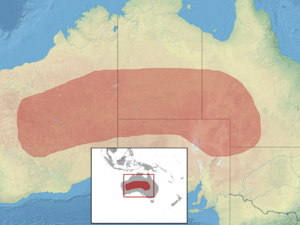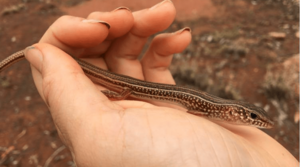Leonhardi's ctenotus facts for kids
Quick facts for kids Leonhardi's ctenotus |
|
|---|---|
| Conservation status | |
| Scientific classification | |
| Genus: |
Ctenotus
|
| Species: |
leonhardii
|
 |
|
The Ctenotus leonhardii, also called Leonhardi's skink or common desert ctenotus, is a type of skink. This lizard lives in dry and partly dry areas across mainland Australia. It was named in 1919 after a German scientist, Moritz von Leonhardi. This skink belongs to the Ctenotus group, which is one of the biggest groups of lizards in Australia.
Contents
What Does Leonhardi's Skink Look Like?
Leonhardi's skink is a small, thin lizard that lives on the ground. It is usually brown or yellowish-brown on top. Sometimes, it has a dark brown stripe down its back. Pale stripes run from its eyes all the way to its tail. These stripes often have a dark brown edge.
Below these stripes, there is a darker, sometimes black, stripe. This stripe has a cool pattern of white spots. A light cream stripe goes from its leg area towards its sides. It has white spots near its front legs. This pale stripe continues down its tail.
Like all Ctenotus species, Leonhardi's skink has four legs. Each leg has five toes. Their scales are smooth. They also have a special row of small scales near their ears.
Adult Leonhardi's skinks can grow up to about 7.9 centimeters long. They usually weigh around 9.14 grams. Both males and females grow to be about the same size. This is different from many other Ctenotus species. Leonhardi's skinks grow slowly. They become adults when they are about 18 months old. Young skinks grow about 0.22 millimeters each day after hatching. They often live for 5 years. The oldest one ever found lived for 7 years.
How Scientists Group Leonhardi's Skink
Leonhardi's skink was named by Moritz von Leonhardi in 1919. It is part of the Scincidae family, which are all skinks. It belongs to the Ctenotus group. In the past, this group was part of Sphenomorphus. But in 1964, Ctenotus became its own group.
Ctenotus species are often called 'comb-eared skinks'. This is because of the small scales near their ears. Ctenotus is one of the largest groups of lizards in Australia. It has almost 100 different species! It is very common in Australia's dry and semi-dry areas. It is also one of the most diverse groups of land animals in the world. Ctenotus is divided into smaller 'species groups'. These groups are based on how similar the skinks look. Leonhardi's skink belongs to the Ctenotus leonhardii group.
Where Does Leonhardi's Skink Live?
Leonhardi's skink lives in the dry and semi-dry parts of Australia. You can find it in central Western Australia. It also lives in the southern Northern Territory, northern South Australia, southwest Queensland, and northwest New South Wales. It is a common lizard in these areas. You can often see it warming up in the sun during the morning.
Leonhardi's Skink's Home and Habits
Leonhardi's skink lives in many dry places. These include open grasslands and sandy deserts. It also lives in semi-dry shrublands. It is very common in areas with acacia trees and chenopod plants. It likes places with lots of grass on the ground.
Plants like spinifex give them protection. They hide from predators and harsh weather in these plants. Spinifex also provides many insects for them to eat. In chenopod areas, this skink is often found near many Maireana plants. It is a burrowing skink. It hides in burrows that have at least two entrances.
Like many lizards, Leonhardi's skink can survive in hot deserts. They are cold-blooded. This means their body temperature changes with the outside temperature. They can slow down their body processes in harsh conditions. This is called aestivation.
However, Leonhardi's skink is active during the day. It even moves around during the hottest hours! Because of this, they have the highest active body temperature of any skink.
Leonhardi's skink usually stays in an area of 20 to 60 meters. This is similar to other Ctenotus species. Leonhardi's skink eats meat. It mostly eats insects. They actively search for food. They look for prey in the open spaces between grasses and other plants. They do most of their hunting around midday. Their diet includes cockroaches, spiders, and grasshoppers. They also eat silverfish, beetles, and moth or butterfly larvae. Unlike most other Ctenotus species, they rarely eat termites. But they will eat them if other food is hard to find.
Big lizards like Gould's goanna (Varanus gouldii) and rusty desert monitor (Varanus eremius) hunt Leonhardi's skinks. Foxes, which are not native to Australia, also hunt them. When there are many foxes, fewer skinks are found. This suggests foxes eat them too.
The number of Leonhardi's skinks goes down when there is more rain. They are most common during long dry periods. But, individual skinks are healthier in years with more rain. Leonhardi's skink often lives near many other Ctenotus species. Up to 14 different species from this group can live in the same area.
Reproduction and Life Cycle
Leonhardi's skinks reproduce sexually. They usually mate and lay eggs in Spring. This can happen anywhere from October to February. They are oviparous, which means they lay eggs. On average, they lay 5 eggs.
However, the number of eggs can change a lot. It depends on the weather and environment. In some years, they might not reproduce successfully at all. The number of eggs also varies in different regions. In South Australia, they often only have 2 young. But in the Great Victoria Desert, they regularly lay up to 7 eggs. Not many young skinks survive. Only about 10-30% of them live to become adults.
Is Leonhardi's Skink in Danger?
Leonhardi's skink is listed as a species of Least Concern by the IUCN. This means it is not currently in danger of disappearing. It is a common and widespread species in the places it likes to live.



